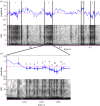Growling from the gut: co-option of the gastric mill for acoustic communication in ghost crabs
- PMID: 31506058
- PMCID: PMC6742986
- DOI: 10.1098/rspb.2019.1161
Growling from the gut: co-option of the gastric mill for acoustic communication in ghost crabs
Abstract
Animal acoustic communication systems can be built upon co-opted structures that become specialized for sound production or morphological novelties. The ghost crab, Ocypode quadrata, evolved a novel stridulation apparatus on the claws that is used during agonistic interactions, but they also produce a rasping sound without their claw apparatus. We investigated the nature of these sounds and show that O. quadrata adopted a unique and redundant mode of sound production by co-opting the gastric mill (grinding teeth of the foregut). Acoustic characteristics of the sound are consistent with stridulation and are produced by both male and female crabs during aggressive interactions. Laser Doppler vibrometry localized the source of maximum vibration to the gastric region and fluoroscopy showed movement of the gastric mill that coincided with stridulation. The lateral teeth of the gastric mill possess a series of comb-like structures that rub against the median tooth to produce stridulation with dominant frequencies below 2 kHz. This previously undescribed gastric stridulation can be modulated and provide a means of assessment during aggressive interactions, similar to the use of the claw stridulation apparatus. This functional redundancy of stridulation in crabs offers unique insights into the mechanisms of evolution of acoustic communication systems.
Keywords: Crustacea; Ocypode; animal behaviour; bioacoustics; functional morphology.
Conflict of interest statement
The authors declare no competing interests.
Figures




Similar articles
-
Morphology of the gastric mill teeth in dotillid crabs (Crustacea: Brachyura: Dotillidae) from Indonesia.J Morphol. 2023 Jul;284(7):e21605. doi: 10.1002/jmor.21605. J Morphol. 2023. PMID: 37313771
-
Acoustic defence in an insect: characteristics of defensive stridulation and differences between the sexes in the tettigoniid Poecilimon ornatus (Schmidt 1850).Zoology (Jena). 2014 Oct;117(5):329-36. doi: 10.1016/j.zool.2014.04.007. Epub 2014 Aug 2. Zoology (Jena). 2014. PMID: 25156932
-
Mechanisms of high-frequency song generation in brachypterous crickets and the role of ghost frequencies.J Exp Biol. 2013 Jun 1;216(Pt 11):2001-11. doi: 10.1242/jeb.083964. Epub 2013 Feb 21. J Exp Biol. 2013. PMID: 23430987
-
Sexual selection and predation drive the repeated evolution of stridulation in Heteroptera and other arthropods.Biol Rev Camb Philos Soc. 2023 Jun;98(3):942-981. doi: 10.1111/brv.12938. Epub 2023 Feb 14. Biol Rev Camb Philos Soc. 2023. PMID: 36787892 Review.
-
Acoustic detection and communication by decapod crustaceans.J Comp Physiol A. 2001 Mar;187(2):83-9. doi: 10.1007/s003590100184. J Comp Physiol A. 2001. PMID: 15523997 Review.
Cited by
-
Acoustic particle motion detection in the snapping shrimp (Alpheus richardsoni).J Comp Physiol A Neuroethol Sens Neural Behav Physiol. 2021 Sep;207(5):641-655. doi: 10.1007/s00359-021-01503-4. Epub 2021 Jul 9. J Comp Physiol A Neuroethol Sens Neural Behav Physiol. 2021. PMID: 34241712
-
Mechanical properties, degree of sclerotisation and elemental composition of the gastric mill in the red swamp crayfish Procambarus clarkii (Decapoda, Crustacea).Sci Rep. 2022 Oct 23;12(1):17799. doi: 10.1038/s41598-022-22724-w. Sci Rep. 2022. PMID: 36274188 Free PMC article.
-
Evolutionary novelty in communication between the sexes.Biol Lett. 2021 Feb;17(2):20200733. doi: 10.1098/rsbl.2020.0733. Epub 2021 Feb 3. Biol Lett. 2021. PMID: 33529546 Free PMC article.
References
-
- Gould SJ, Vrba ES. 1982. Exaptation—a missing term in the science of form. Paleobiology 8, 4–15. (10.1017/S0094837300004310) - DOI
-
- McLennan DA. 2008. The concept of co-option: why evolution often looks miraculous. Evol. Educ. Outreach 1, 247–258. (10.1007/s12052-008-0053-8) - DOI
-
- Parmentier E, Diogo R, Fine ML. 2017. Multiple exaptations leading to fish sound production. Fish Fish. 18, 958–966. (10.1111/faf.12217) - DOI
-
- Dumortier B. 1963. Morphology of sound emission apparatus in Arthropoda. In Acoustic behaviour of animals (ed. Busnel R-G.), pp. 277–345. Amsterdam, The Netherlands: Elsevier.

